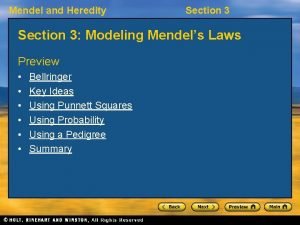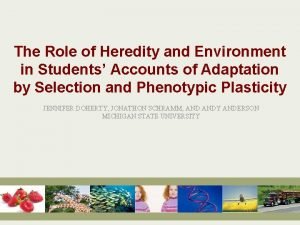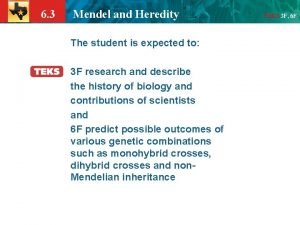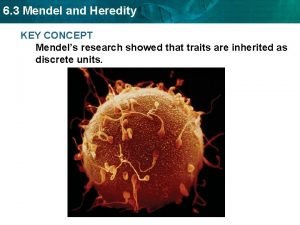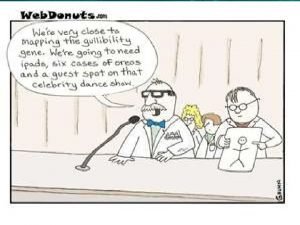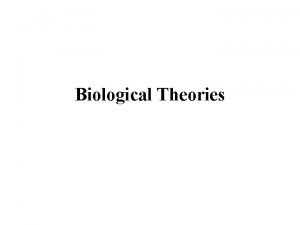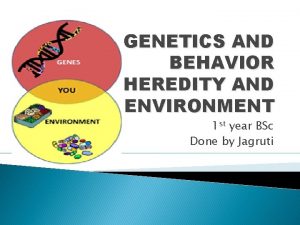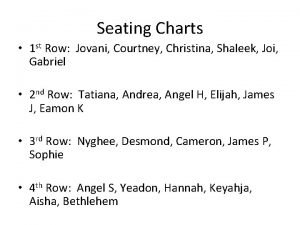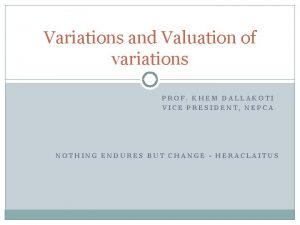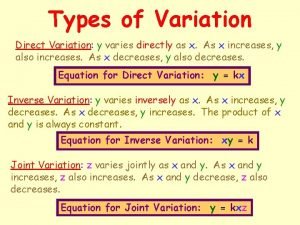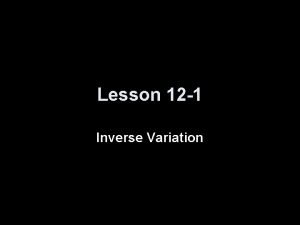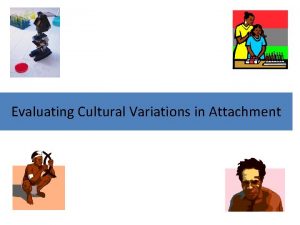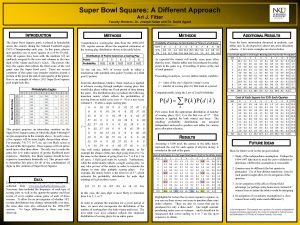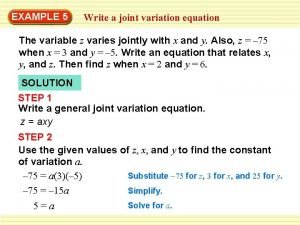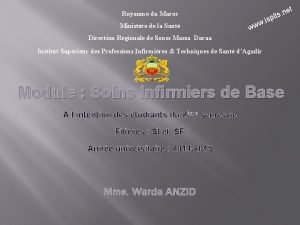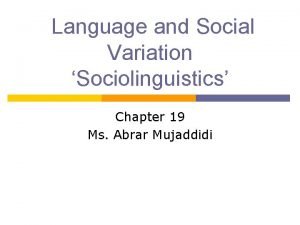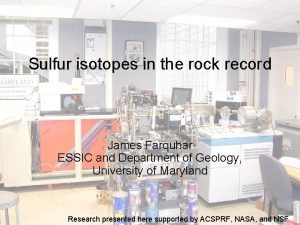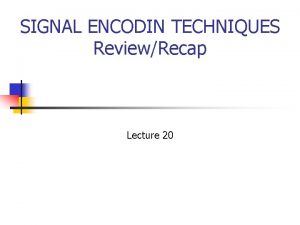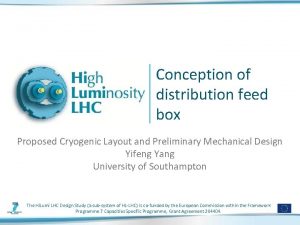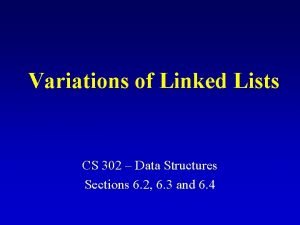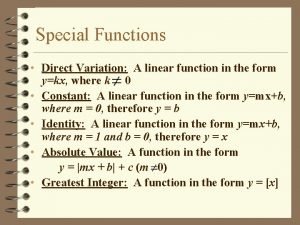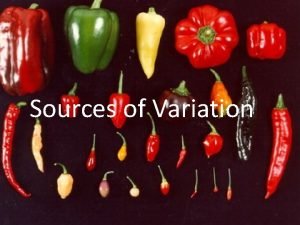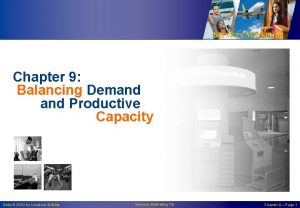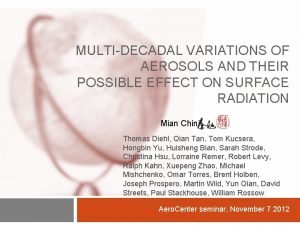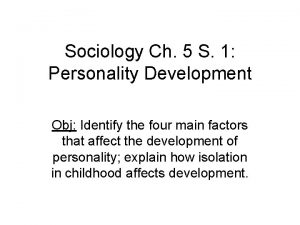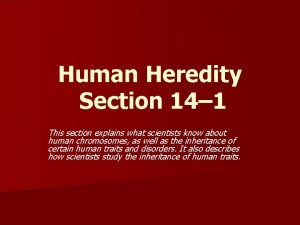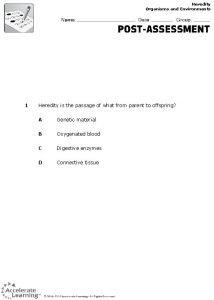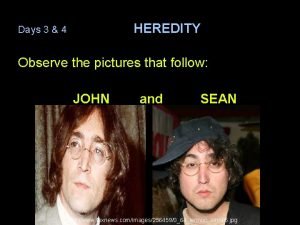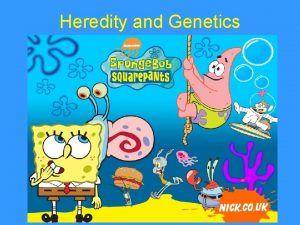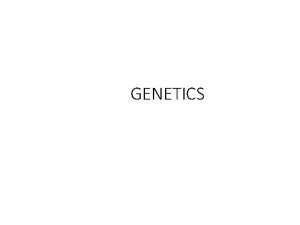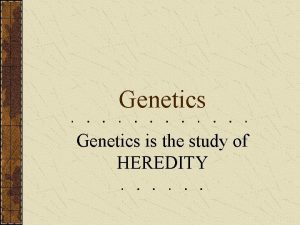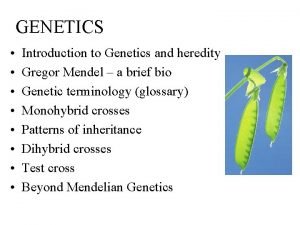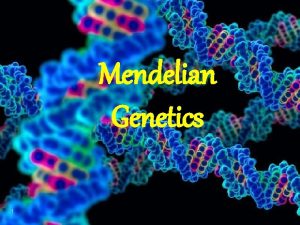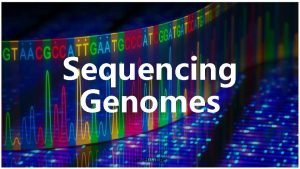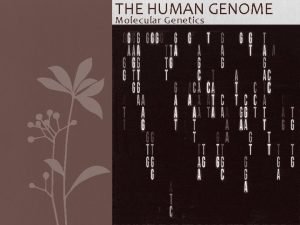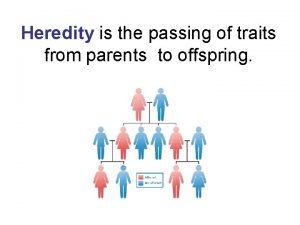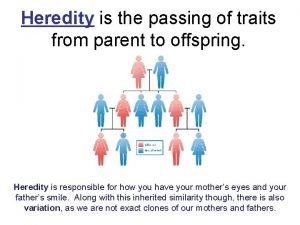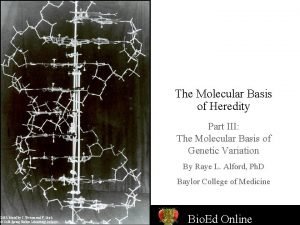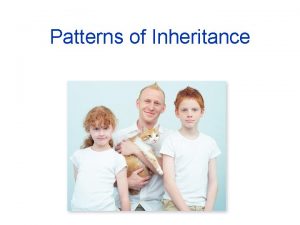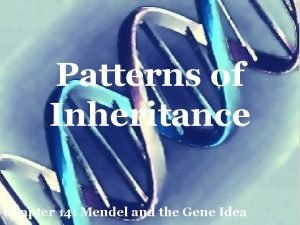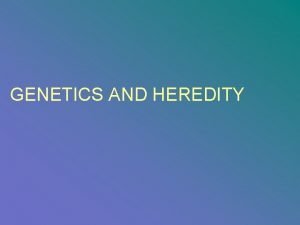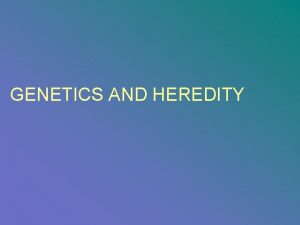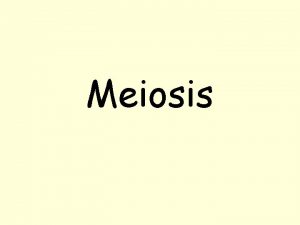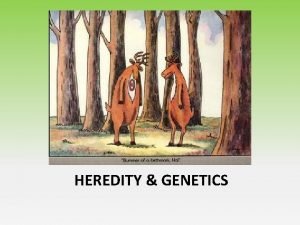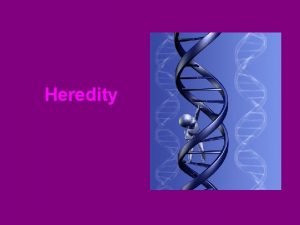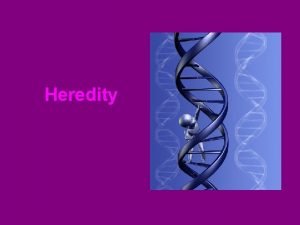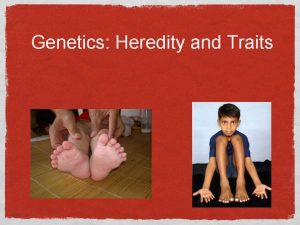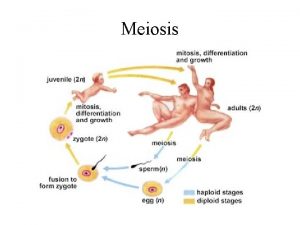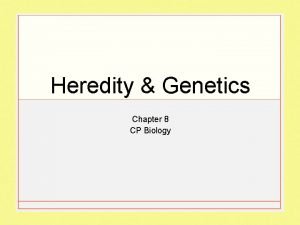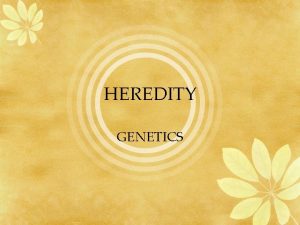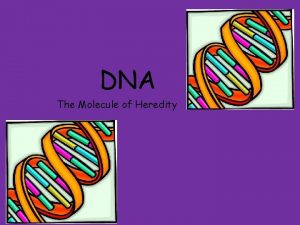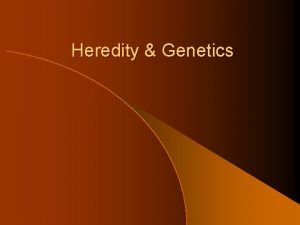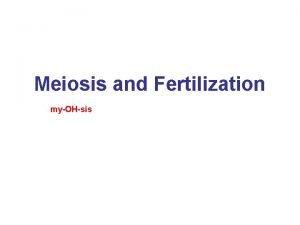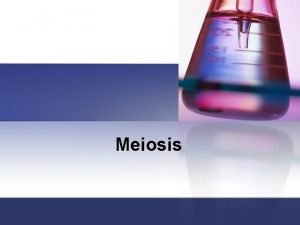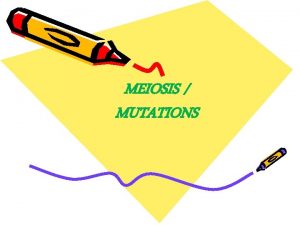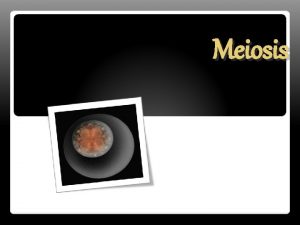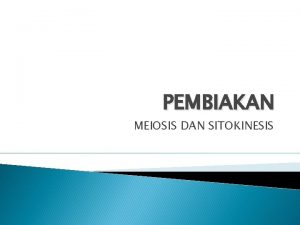MEIOSIS AND HEREDITY OVERVIEW VARIATIONS ON A THEME



































































- Slides: 67

MEIOSIS AND HEREDITY!

OVERVIEW: VARIATIONS ON A THEME Living organisms are distinguished by their ability to reproduce their own kind © 2011 Pearson Education, Inc.

VOCAB REVIEW… Genetics - study of heredity and variation Heredity - transmission of traits from one generation to the next Variation is the differences

FIGURE 13. 1

HOW DOES HEREDITY HAPPEN? Genes: parents offspring through chromosomes Children inherit genes, not traits Genes - the units of heredity § made up of segments of DNA © 2011 Pearson Education, Inc.

INHERITANCE OF GENES – THE BASICS Genes - passed on via gametes § (sperm and eggs) Each gene has a specific location on a certain chromosome called a locus Most DNA is packaged into chromosomes © 2011 Pearson Education, Inc.

ASEXUAL VS. SEXUAL REPRODUCTION Asexual - a single individual §NO fusion of gametes Clone - genetically identical individuals from the same parent Sexual reproduction – 2 parents, offspring have unique combinations of genes http: //www. youtube. com/watch? v=-B 7 ANli 2 xf. Y © 2011 Pearson Education, Inc.

FIGURE 13. 2 0. 5 mm Parent Bud (a) Hydra (b) Redwoods

WHAT ABOUT US? Humans have 23 pairs of chromosomes in somatic cells (any cell other than a gamete) Somatic cells are 2 n (diploid = 2 sets) because there is one set of chromosomes from ma and one from pa Karyotype © 2011 Pearson Education, Inc.

The two chromosomes in each pair are called homologous chromosomes, or homologs Homologous pairs are: - same length - Same shape - carry genes for the same inherited characters

For humans, the diploid number is 46 Somatic cell = (2 n = 46) Gamete (n=23) © 2011 Pearson Education, Inc.

SEX CHROMOSOMES X and Y Human females have (XX) Human males (XY) Autosomes - The remaining 22 pairs of chromosomes (non-sex chromosomes) © 2011 Pearson Education, Inc.

FIGURE 13. 3 APPLICATION TECHNIQUE Pair of homologous duplicated chromosomes Centromere Sister chromatids Metaphase chromosome 5 m

FIGURE 13. 3 B Pair of homologous duplicated chromosomes Centromere Sister chromatids Metaphase chromosome 5 m

FIGURE 13. 4 Key 2 n 6 Maternal set of chromosomes (n 3) Paternal set of chromosomes (n 3) Sister chromatids of one duplicated chromosome Two nonsister chromatids in a homologous pair Centromere Pair of homologous chromosomes (one from each set)

Fertilization and meiosis alternate in sexual life cycles © 2011 Pearson Education, Inc.

Fertilization (the union of gametes) zygote mitosis (growth/development) adult meiosis gametes …and the cycle repeats… © 2011 Pearson Education, Inc.

Or in terms of chromosomes sets… n + n 2 n (fertilization) 2 n n (gamete production/meiosis) Fertilization and meiosis alternate in sexual life cycles to maintain chromosome number **1 n = haploid © 2011 Pearson Education, Inc.

FIGURE 13. 5 Haploid gametes (n 23) Key Haploid (n) Diploid (2 n) Egg (n) Sperm (n) MEIOSIS Ovary FERTILIZATION Testis Diploid zygote (2 n 46) Mitosis and development Multicellular diploid adults (2 n 46)

THE VARIETY OF SEXUAL LIFE CYCLES - Three main types of sexual life cycles - Differ in the timing of meiosis and fertilization © 2011 Pearson Education, Inc.

FIGURE 13. 6 Key Haploid (n) Diploid (2 n) n Gametes n Mitosis n MEIOSIS n FERTILIZATION n Diploid multicellular organism (a) Animals Zygote 2 n Mitosis n 2 n Diploid multicellular organism (sporophyte) Mitosis n Spores Gametes MEIOSIS 2 n Haploid unicellular or multicellular organism Haploid multicellular organism (gametophyte) n n Gametes FERTILIZATION (b) Plants and some algae n FERTILIZATION MEIOSIS 2 n Zygote Mitosis 2 n Zygote (c) Most fungi and some protists

FIGURE 13. 6 A Key Haploid (n) Diploid (2 n) n We are familiar with this one… Gametes n n MEIOSIS FERTILIZATION 2 n Zygote 2 n Diploid multicellular organism Mitosis (a) Animals

Animals… • Gametes are the only haploid cells in animals § are produced by meiosis § undergo no further cell division before fertilization • Gametes fuse to form a 2 n zygote that divides by mitosis to develop into a multicellular organism © 2011 Pearson Education, Inc.

SOME PLANTS AND ALGAE DO THINGS DIFFERENTLY And we call it an alternation of generations - life cycle includes both a 2 n and 1 n multicellular stage - The 2 n organism (sporophyte) makes haploid (1 n) spores by meiosis © 2011 Pearson Education, Inc.

- spore grows (mitosis) haploid organism called a gametophyte - gametophyte makes haploid gametes by mitosis - Fertilization of gametes results in a diploid sporophyte © 2011 Pearson Education, Inc.

FIGURE 13. 6 B Key Haploid (n) Diploid (2 n) Haploid multicellular organism (gametophyte) Mitosis n n Spores Gametes MEIOSIS 2 n Diploid multicellular organism (sporophyte) n FERTILIZATION 2 n Zygote Mitosis (b) Plants and some algae

And then we have fungi and some protists… - 2 n zygote (meiosis) haploid cells make 1 n multicellular organism - haploid adult produces gametes by mitosis © 2011 Pearson Education, Inc.

FIGURE 13. 6 C Key Haploid (n) Diploid (2 n) Haploid unicellular or multicellular organism Mitosis n n n Mitosis n Gametes MEIOSIS n FERTILIZATION 2 n Zygote (c) Most fungi and some protists

A NOTE ON HAP & DIP • either 1 n or 2 n cells can divide by mitosis • only diploid cells can undergo meiosis In all three life cycles, the halving and doubling of chromosomes contributes to… genetic variation in offspring © 2011 Pearson Education, Inc.

MEIOSIS • Halves # of chromosomes • is preceded by the replication of chromosomes • two sets of cell divisions, called meiosis I and meiosis II • Results in 4 unique daughter cells – each with one set of unduplicated chromosomes Each daughter cell has only half as many chromosomes as the parent cell © 2011 Pearson Education, Inc.

FIGURE 13. UN 04

FIGURE 13. 7 -1 Interphase Pair of homologous chromosomes in diploid parent cell Duplicated pair of homologous chromosomes Sister chromatids Chromosomes duplicate Diploid cell with duplicated chromosomes

FIGURE 13. 7 -2 Interphase Pair of homologous chromosomes in diploid parent cell Duplicated pair of homologous chromosomes Sister chromatids Chromosomes duplicate Diploid cell with duplicated chromosomes Meiosis I 1 Homologous chromosomes separate Haploid cells with duplicated chromosomes

FIGURE 13. 7 -3 Interphase Pair of homologous chromosomes in diploid parent cell Duplicated pair of homologous chromosomes Sister chromatids Chromosomes duplicate Diploid cell with duplicated chromosomes Meiosis I 1 Homologous chromosomes separate Haploid cells with duplicated chromosomes Meiosis II 2 Sister chromatids separate Haploid cells with unduplicated chromosomes

THE ORDER OF EVENTS… Interphase (2 n, chromosomes replicate) àMeiosis I (2 daughter cells) Meiosis II (1 n, 4 daughter cells) Bio. Flix: Meiosis http: //www. youtube. com/watch? v=k. VMb 4 Js 99 t. A © 2011 Pearson Education, Inc.

FIGURE 13. 8 MEIOSIS I: Separates sister chromatids MEIOSIS I: Separates homologous chromosomes Prophase I Metaphase I Centrosome (with centriole pair) Sister chromatids Chiasmata Fragments of nuclear envelope Duplicated homologous chromosomes (red and blue) pair and exchange segments; 2 n 6 in this example. Prophase II Metaphase II Anaphase II Telophase II and Cytokinesis Sister chromatids remain attached Centromere (with kinetochore) Spindle Homologous chromosomes Telophase I and Cytokinesis Anaphase I Metaphase plate Homologous chromosomes separate Microtubule attached to kinetochore Chromosomes line up by homologous pairs. Cleavage furrow Each pair of homologous chromosomes separates. During another round of cell division, the sister chromatids finally separate; four haploid daughter cells result, containing unduplicated chromosomes. Sister chromatids separate Two haploid cells form; each chromosome still consists of two sister chromatids. Haploid daughter cells forming

SO, IN BRIEF… - Meiosis I separates Homologous Chromosomes - Meiosis II separates Sister Chromatids

FIGURE 13. 8 A Prophase I Centrosome (with centriole pair) Sister chromatids Chiasmata Spindle Telophase I and Cytokinesis Anaphase I Metaphase I Sister chromatids remain attached Centromere (with kinetochore) Metaphase plate Fragments Homologous chromosomes of nuclear envelope Homologous chromosomes separate Microtubule attached to kinetochore Cleavage furrow Each pair of homologous chromosomes separates. Chromosomes line up Duplicated homologous chromosomes (red and blue) by homologous pairs. pair and exchange segments; 2 n 6 in this example. Two haploid cells form; each chromosome still consists of two sister chromatids.

FIGURE 13. 8 B Prophase II Metaphase II Anaphase II Telophase II and Cytokinesis During another round of cell division, the sister chromatids finally separate; four haploid daughter cells result, containing unduplicated chromosomes. Sister chromatids separate Haploid daughter cells forming

And at the end of meiosis… Each daughter cell is genetically distinct from the others and from the parent cell © 2011 Pearson Education, Inc.

A COMPARISON OF MITOSIS AND MEIOSIS Mitosis : cells 2 n (diploid diploid) • daughter cells identical to parent • Growth and repair • 1 division Meiosis: 2 n 1 n (diploid haploid) - daughter cells unique from parents and each other • - Synapsis and Crossing over occur • - 2 divisions © 2011 Pearson Education, Inc.

FIGURE 13. 9 A MEIOSIS MITOSIS Parent cell MEIOSIS I Chiasma Prophase I Duplicated chromosome Chromosome duplication 2 n 6 Chromosome duplication Homologous chromosome pair Metaphase I Anaphase Telophase Anaphase I Telophase I Daughter cells of meiosis I 2 n Daughter cells of mitosis 2 n Haploid n 3 MEIOSIS II n n Daughter cells of meiosis II

FIGURE 13. 9 B SUMMARY Property Mitosis Meiosis DNA replication Occurs during interphase before mitosis begins Occurs during interphase before meiosis I begins Number of divisions One, including prophase, metaphase, and telophase Two, each including prophase, metaphase, and telophase Synapsis of homologous chromosomes Does not occur Occurs during prophase I along with crossing over between nonsister chromatids; resulting chiasmata hold pairs together due to sister chromatid cohesion Number of daughter cells and genetic composition Two, each diploid (2 n) and genetically identical to the parent cell Four, each haploid (n), containing half as many chromosomes as the parent cell; genetically different from the parent cell and from each other Role in the animal body Enables multicellular adult to arise from zygote; produces cells for growth, repair, and, in some species, asexual reproduction Produces gametes; reduces number of chromosomes by half and introduces genetic variability among the gametes

ONE MORE LITTLE DIFFERENCE BETWEEN MITOSIS AND MEIOSIS… Sister chromatids are held together during division by protein complexes called cohesins Mitosis: cohesins are cleaved at the end of metaphase Meiosis: cohesins are cleaved along the chromosome arms in anaphase I (separation of homologs) and at the centromeres in anaphase II (separation of sister chromatids) © 2011 Pearson Education, Inc.

ORIGINS OF GENETIC VARIATION AMONG OFFSPRING • Three mechanisms contribute to genetic variation §Independent assortment of chromosomes §Crossing over §Random fertilization © 2011 Pearson Education, Inc.

1. CROSSING OVER • Prophase I • nonsister chromatids exchange DNA segments • Creates recombinant chromosomes © 2011 Pearson Education, Inc.

CROSSING OVER • Each pair of chromosomes lines up gene by gene and forms a tetrad (group of 4 chromatids) • Each tetrad has one or more chiasmata (X-shaped regions where crossing over occurred) • Homologous portions of two nonsister chromatids trade places © 2011 Pearson Education, Inc.

In crossing over, homologous portions of two nonsister chromatids trade places Crossing over contributes to genetic variation by combining DNA from two parents into a single chromosome © 2011 Pearson Education, Inc.

FIGURE 13. 11 -1 Prophase I of meiosis Pair of homologs Nonsister chromatids held together during synapsis

FIGURE 13. 11 -2 Prophase I of meiosis Pair of homologs Chiasma Centromere TEM Nonsister chromatids held together during synapsis

FIGURE 13. 11 -3 Prophase I of meiosis Pair of homologs Chiasma Centromere TEM Anaphase I Nonsister chromatids held together during synapsis

FIGURE 13. 11 -4 Prophase I of meiosis Pair of homologs Chiasma Centromere TEM Anaphase II Nonsister chromatids held together during synapsis

FIGURE 13. 11 -5 Prophase I of meiosis Pair of homologs Nonsister chromatids held together during synapsis Chiasma Centromere TEM Anaphase II Daughter cells Recombinant chromosomes

FIGURE 13. 11 A Chiasma Centromere TEM

2. INDEPENDENT ASSORTMENT OF CHROMOSOMES Homologous pairs of chromosomes orient randomly at metaphase I of meiosis Each pair of chromosomes are sorted independently of the other pairs (Law of Segregation states that allele pairs separate during meiosis and then recombine during fertilization) © 2011 Pearson Education, Inc.

The number of combinations possible when chromosomes assort independently into gametes is 2 n, where n is the haploid number For humans (n = 23), there are more than 8 million (223) possible combinations of chromosomes © 2011 Pearson Education, Inc.

FIGURE 13. 10 -1 Possibility 2 Possibility 1 Two equally probable arrangements of chromosomes at metaphase I

FIGURE 13. 10 -2 Possibility 1 Two equally probable arrangements of chromosomes at metaphase I Metaphase II

FIGURE 13. 10 -3 Possibility 2 Possibility 1 Two equally probable arrangements of chromosomes at metaphase I Metaphase II Daughter cells Combination 1 Combination 2 Combination 3 Combination 4

3. RANDOM FERTILIZATION • any sperm can fuse with any ovum (unfertilized egg) • fusion of two gametes (each with 8. 4 million possible chromosome combinations from independent assortment) produces a zygote with any of about 70 trillion diploid combinations © 2011 Pearson Education, Inc.

Crossing over adds even more variation Each zygote has a unique genetic identity Animation: Genetic Variation © 2011 Pearson Education, Inc.

THE GOOD OLE’ EVOLUTION CONNECTION… (Genetic variation produced in sexual life cycles contributes to evolution) • Mutations (changes in an organism’s DNA) are the original source of genetic diversity • Mutations create different versions of genes called alleles • Reshuffling of alleles during sexual reproduction produces genetic variation © 2011 Pearson Education, Inc.

THE EVOLUTIONARY SIGNIFICANCE OF GENETIC VARIATION WITHIN POPULATIONS • Natural selection results in the accumulation of genetic variations favored by the environment Therefore…. Sexual reproduction contributes to the genetic variation in a population, which originates from mutations © 2011 Pearson Education, Inc.

FIGURE 13. 12 200 m

FIGURE 13. UN 01 Prophase I: Each homologous pair undergoes synapsis and crossing over between nonsister chromatids with the subsequent appearance of chiasmata. Metaphase I: Chromosomes line up as homologous pairs on the metaphase plate. Anaphase I: Homologs separate from each other; sister chromatids remain joined at the centromere.

FIGURE 13. UN 02 F H

FIGURE 13. UN 03
 Concept mapping chapter 10 meiosis 1 and meiosis 2
Concept mapping chapter 10 meiosis 1 and meiosis 2 Difference between meiosis 1 and meiosis 2
Difference between meiosis 1 and meiosis 2 Section quick check chapter 10 section 1 meiosis answer key
Section quick check chapter 10 section 1 meiosis answer key Chapter 10 section 10.2 meiosis worksheet answer key
Chapter 10 section 10.2 meiosis worksheet answer key Meiosis vs mitosis anaphase
Meiosis vs mitosis anaphase Meiosis 1 and 2
Meiosis 1 and 2 Meiosis 1 vs meiosis 2
Meiosis 1 vs meiosis 2 Computer organization & architecture: themes and variations
Computer organization & architecture: themes and variations Stability factor must be
Stability factor must be Section 3 mendel and heredity
Section 3 mendel and heredity Genetics is the study of heredity and variation.
Genetics is the study of heredity and variation. Chapter 11 complex inheritance and human heredity test
Chapter 11 complex inheritance and human heredity test Part of the chromosome
Part of the chromosome Role of heredity
Role of heredity Section 3 mendel and heredity
Section 3 mendel and heredity Mendel 9 3 3 1
Mendel 9 3 3 1 Section 3 mendel and heredity
Section 3 mendel and heredity Section 3 mendel and heredity
Section 3 mendel and heredity Heredity and crime
Heredity and crime Heredity and environment slideshare
Heredity and environment slideshare Flocabulary genes and heredity answer key
Flocabulary genes and heredity answer key Chapter 17 the beginning of the life cycle
Chapter 17 the beginning of the life cycle Valuation of variations
Valuation of variations Kinds of variation
Kinds of variation How do we identify problems involving inverse
How do we identify problems involving inverse Kwl plus chart
Kwl plus chart Cultural variations in attachment
Cultural variations in attachment Super bowl squares variations
Super bowl squares variations Combined variation examples
Combined variation examples Variations pathologiques de la température
Variations pathologiques de la température Uni-factor theory of intelligence by alfred binet
Uni-factor theory of intelligence by alfred binet Sine rule examples
Sine rule examples Variations de stock
Variations de stock What is social variation in language
What is social variation in language Possible variations
Possible variations Possible variations
Possible variations Language variation and change examples
Language variation and change examples Possible variations
Possible variations Linked list variations
Linked list variations Are all linear functions direct variations
Are all linear functions direct variations Youtube-com
Youtube-com Snow white and the seven genders
Snow white and the seven genders Variations in demand relative to capacity
Variations in demand relative to capacity Variations
Variations Variations
Variations Upper specification limit and lower specification limit
Upper specification limit and lower specification limit Genetic vocabulary worksheet answer key
Genetic vocabulary worksheet answer key An unchanging, biologically inherited behavior pattern.
An unchanging, biologically inherited behavior pattern. Mendelian genetics concept map
Mendelian genetics concept map 14-1 human heredity
14-1 human heredity Heredity defines the passage of genetic material from
Heredity defines the passage of genetic material from Pictures of heredity
Pictures of heredity Allele
Allele Heredity
Heredity ____________ is the study of heredity.
____________ is the study of heredity. Mendelian principles
Mendelian principles Chapter 11 human heredity section 11-3
Chapter 11 human heredity section 11-3 Heredity terminology
Heredity terminology The basic units of heredity
The basic units of heredity Chapter 14 human heredity
Chapter 14 human heredity Heredity torrent
Heredity torrent Heredity
Heredity Flower structure
Flower structure Organisms that reproduce asexually
Organisms that reproduce asexually Cpalms heredity tutorial
Cpalms heredity tutorial Molecular basis of heredity
Molecular basis of heredity Early ideas about heredity
Early ideas about heredity Dice and coin
Dice and coin









